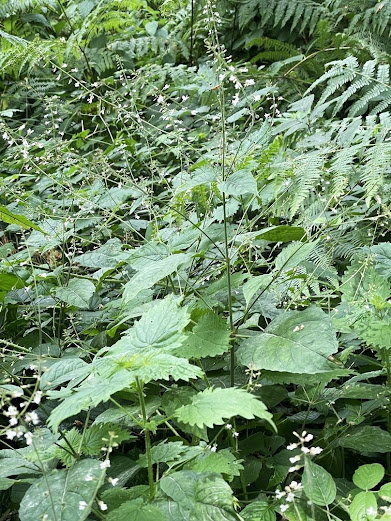Enchanter’s Nightshade
This delicate little perennial grows abundantly in the woods and is a UK native wildflower. In rich moist soil it reaches a height of about 70 cms (28 inches), though it is shorter in drier, less fertile ground. It thrives in semi-shade and provides sustenance and cover for creatures like moths, sawflies and stiltbugs. It is pollinated by small bees and hoverflies.The leaves are oval or heart-shaped with a distinctive pointed tip and grow in pairs on hairy stems. Above them, spikes of well-spaced pinkish buds give rise to small white flowers from June to August.
Image courtesy Wikimedia CommonsFollowing the flowers come seed pods or capsules usually carrying two seeds. The capsules are covered in spiky bristles which readily attach to passing animals, thus helping its distribution.
The plant dies down and disappears underground for the winter, emerging with new growth in the spring.
It belongs with fuchsias and willowherbs in the Onagraceae family. Its common name is misleading as it is not a member of Solonaceae, the nightshade species, but may come from its botanical name, Circaea lutetiana.
The Latin name, Circaea, comes from the enchantress Circe, sometimes known as the Greek goddess of magic, who lived in the woods of the island of Aeaea. She was revered for her knowledge of herbs and skill in making potions and fêted in Homer’s Odyssey because she prevented Odysseus and his men from leaving her island by turning them into pigs.
Lutetia was the Roman name for Paris and the second part of the botanical name, Lutetiana, refers to this, though the connection is a little obscure. Some believe that the city was once known as ‘witch city’ as it had a strong fascination with the occult. There is a carving of Baphomet, the Sabbatic Goat, in the mediaeval church of Saint-Merri, and a pentagram is depicted in stained glass.
Though Enchanter’s Nightshade has been classed as a herb, it has little medicinal value, though it is astringent and has been used to treat wounds, cramp, and skin inflammation. In the highlands of Scotland, it was thought to be an aphrodisiac. It contains a notable amount of tannin and has been used to flavour Austrian tea.
Image courtesy Wikimedia Commons


20cm is 8 inches, a standard width for cake tins, and 28 inches is 71cm which is quite tall. I like reading about the "forgotten" herbs and things they were once used for.
ReplyDeleteI didn't know what it had been used for - one of the more obscure plants.
DeleteYou're right - I've just amended it. Wasn't thinking straight - nothing new there;-)
DeleteIt's very pretty - thanks for the interesting information. xx
ReplyDeleteIt grows all over the woods in semi-shade and dappled shade.
DeleteI love woodland wild flowers, where they spread and fill spaces.
ReplyDeleteIt can be grown in gardens, but can be invasive.
DeleteI can't get past the name nightshade. JB interested in nightshade = look out Barry.
ReplyDeleteWe had some deadly nightshade in the garden - must have been brought in by birds. It looked very pretty but we pulled it up. Barry is safe - for now;-)
DeleteThis is a beautiful plant. Here we have something similar that is nick-named "tick seed" for it small hairy seeds that stick to clothing and of course all animal fur.
ReplyDeleteI think it's such a lovely name.
DeleteSuch a pretty, little thing to have such an ominous name
ReplyDeleteIt belies its true nature.
DeleteI love how you write about the nightshades.
ReplyDeleteThat's kind of you to say :-)
DeleteThis comment has been removed by the author.
ReplyDeleteThat is a lovely plant, I am wondering if it would make a good ground cover up here in the north. Our climate is much like south UK.
ReplyDeleteIt does make good ground cover, but can be invasive.
ReplyDeleteI'd not heard of 'Enchanter’s Nightshade', although I may have see it when out and about.
ReplyDeleteAll the best Jan
It's not flamboyant or scented, just delicate.
DeleteI love the name of it. I enjoy reading about plants and their properties.
ReplyDeleteI like the name, too, and now I shan't forget it - hopefully!
DeleteLindas belladonas. Te mando un beso.
ReplyDeleteIt's not belladonna - it's harmless.
DeleteHi Janice - interesting ... I'd not realised its name ... but have noted your thoughts - cheers Hilary
ReplyDeleteYear after year I saw it and didn't know its name. Hopefully, I'll remember the name now:-)
DeleteI am familiar with the sight of this wildflower but had no idea of its rather enchanting name! xxx
ReplyDeleteI am not good at wildflower names and learn perhaps one a year!
Delete